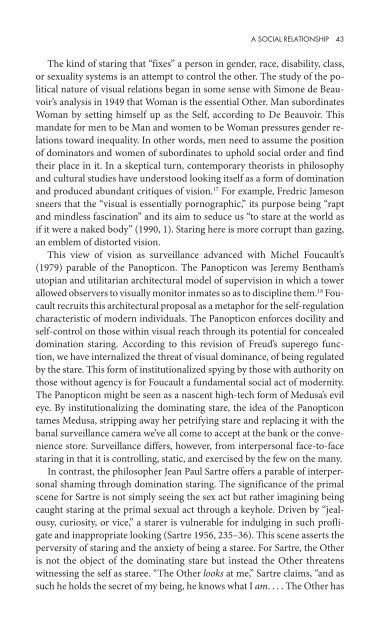Staring how we look sobre la mirada.pdf - artecolonial
Staring how we look sobre la mirada.pdf - artecolonial
Staring how we look sobre la mirada.pdf - artecolonial
You also want an ePaper? Increase the reach of your titles
YUMPU automatically turns print PDFs into web optimized ePapers that Google loves.
2<br />
A Physical Response<br />
. . . the human mind always burns to hear and take in novelties.<br />
—Gervase of Tillbury, Otia imperialia, circa 1210<br />
<strong>Staring</strong> is a universal part of our cognitive architecture that natural selection<br />
has bequeathed us. The evolutionary origin of staring is a startle response.<br />
When staring is intentional—as in the long loving <strong>look</strong> or the hostile g<strong>la</strong>re—<br />
<strong>we</strong> are masters of our eyes. When an unexpected sight grabs our attention,<br />
<strong>how</strong>ever, staring is spontaneous and vo<strong>la</strong>tile. As the epigraph to the previous<br />
section says, “staring, in its pure and simple essence, is the time required by<br />
the brain to make sense of the unexpected.” 1 We cannot, even when <strong>we</strong> try,<br />
ignore compelling visual stimuli; <strong>we</strong> can only withdraw the stare once it is in<br />
p<strong>la</strong>y (Yantis 1998, 239). Intense, persistent <strong>look</strong>ing and the ability to interpret<br />
such stares are fundamental to our survival as social beings as <strong>we</strong>ll. Human<br />
infants and mothers stare long and emphatically at each other to cement their<br />
re<strong>la</strong>tionship (Baron-Cohen 1985, 39). We enact social hierarchies through<br />
visual dominance disp<strong>la</strong>ys (Ellyson and Dovido 1995). Even very young infants<br />
s<strong>how</strong> surprise by staring for longer periods at scenes that vio<strong>la</strong>te the<br />
<strong>la</strong>ws of physics or seem physically imp<strong>la</strong>usible than they <strong>look</strong> at a predictable<br />
or expected event. 2 <strong>Staring</strong> not only signals alertness in the starer, it alerts the<br />
staree. Another’s stare actually excites electrical activity in the brain (Baron-<br />
Cohen 1995, 98). The staring encounter arouses us as <strong>we</strong>ll. Our heart rate<br />
increases when <strong>we</strong> are stared at; being subjected to a stare even registers on<br />
a cortical EEG. So viscerally potent is the staring encounter that <strong>we</strong> can even<br />
feel stares directed at us. In fact, humans from infancy can detect unseen<br />
stares. We not only believe that <strong>we</strong> can tell when <strong>we</strong> are being stared at, but<br />
repeated experiments dating as early as the <strong>la</strong>te nineteenth century suggest<br />
that in fact <strong>we</strong> do (Col<strong>we</strong>ll et al. 2000). <strong>Staring</strong>, then, has vivid physiological<br />
17


